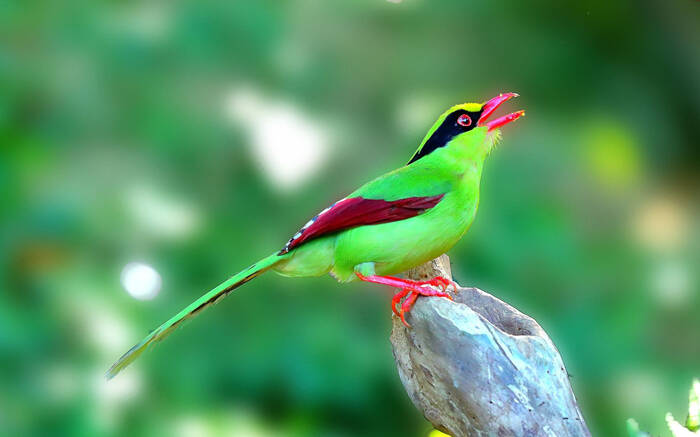Cissa chinensis
IUCN
LCBasic Information
Scientific classification
- name:Cissa chinensis
- Scientific Name:Cissa chinensis,Common Green Magpie
- Outline:Songbird
- Family:Passeriformes Corvidae G.Magpie
Vital signs
- length:33-39cm
- Weight:120-160g
- lifetime:9-11years
Feature
The main feather color is grass green, with a wide black eye pattern extending backward to the back of the neck.
Distribution and Habitat
The world is distributed in Bhutan, Cambodia, China, India, Indonesia, Lao People's Democratic Republic, Malaysia, Myanmar, Nepal, Thailand and Vietnam.
In China, it is distributed in Yingjiang, Cangyuan in western Yunnan, Xishuangbanna and Luchun in the south, as well as southeastern Yunnan, Guangxi, Medog in Tibet and southwestern Qamdo.
It mainly inhabits subtropical evergreen broad-leaved forests in low mountains and hills, and also appears in deciduous broad-leaved forests, secondary forests, bamboo forests, oak forests and open forest edge shrubs, and sometimes appears on trees on the edge of farmland.
Appearance
The entire head and neck of the blue-green magpie are grass-green. There is a long crest hanging down on the head. It is grass-green. From the base of the forehead and the first eye, there is a wide black band that runs through the two eyes and extends back to the back pillow. . The rest of the upper body such as the back, shoulders, waist and tail coverts are green. The tail is also green, with a central tail feather with a white tip and other tail feathers with broad black subterminal spots and white tips. The small wing coverts are green, and the rest of the wing coverts are chestnut red. The outer flight feathers are chestnut red and the inner flight feathers are brown. The inner secondary flight feathers have broad black subterminal spots and white tips.
The iris is blood red, the mouth and feet are red, and the claws are red. The difference from the short-tailed green magpie is that its tail is longer, the top of its head is mostly yellow, and the tips of its third-level fligh
Details
Common Green Magpie, with 5 subspecies.

Common Green Magpie is a resident bird. It often moves alone or in pairs, and sometimes gathers in small groups of 3-5. It mainly feeds on insects such as Lepidoptera, Hymenoptera, beetles, locusts, and also eats small vertebrates. It mainly feeds on trees, but also on the ground and shrubs.
The breeding season of the blue-green magpie is from April to July. It usually nests on trees or tall shrubs, and also nests on bamboo bushes. The nest is cup-shaped, mainly made of dead branches, dead grass stems, grass leaves, roots, bamboo leaves and other materials, and is padded with fine grass roots. Each nest lays 3-7 eggs, mostly 4-5 eggs, the eggs are grayish white, white or light red, and the size is 30.2 mm × 22.9 mm.
Listed in the IUCN Red List of Threatened Species in 2018 ver 3.1 - Least Concern (LC).
Listed in the List of Terrestrial Wildlife with Important Economic and Scientific Research Value under State Protection (Item 419) issued by the State Forestry Administration of China on August 1, 2000.
Listed in the second level of China's National Key Protected Wildlife List (February 5, 2021).
Protect wild animals and stop eating game.
Maintaining ecological balance is everyone's responsibility!








